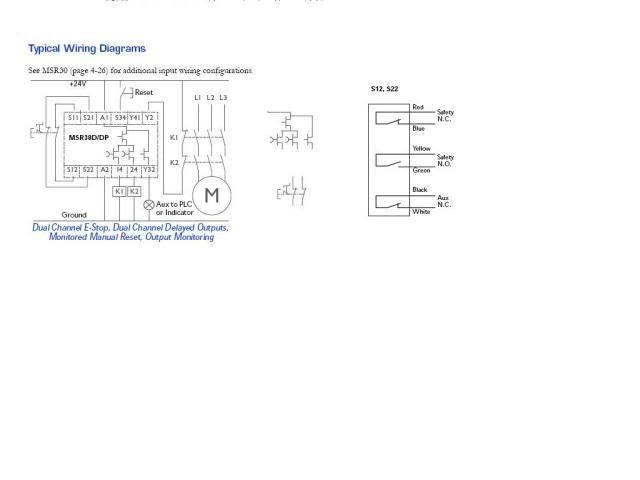I wonder if someone would be so kind as to explain some things to me about the safety relays and switches that follow, re: Allen bradley safety relays.

The center of the picture has selections from the diagram on the left. I am unfamiliar with the symbols used...
1. What kind of switch is that in the center bottom?
2. What are the symbols in the center top... F.E.T'.s?
3. Which are timed?
Link to more info re: safety relay
http://www.ab.com/catalogs/safety/prodtypepdf/ch4/4-46_4-47.pdf
The symbol on the right is a "switch" that is used with the relay on the left. It is obviously not just a normal switch because I cannot read through the normally closed contacts with an ohmeter.
4. What exactly is this switch?
http://www.ab.com/catalogs/safety/prodtypepdf/ch3/3-60_3-63.pdf
I don't know what terminology to use when something is not as it is represented on the drawings. I see on the prints from a job where these are used, that they are "hooked up in series" with other switches of the same kind.
.
5. If they are not switches, which it seems to me they are not, in the literal sense of the word, can they me hooked in series?... how many? Does it matter how many?
I have a big long rant I would like to unload , but I will spare you. The links I have posted are about as good as anything I was able to find re: these items. Surely there is better and more detailed information out there than this. If someone can point me to it, I will remember you at Christmas...
I won't send you nothin' , but I'll remember you..

The center of the picture has selections from the diagram on the left. I am unfamiliar with the symbols used...
1. What kind of switch is that in the center bottom?
2. What are the symbols in the center top... F.E.T'.s?
3. Which are timed?
Link to more info re: safety relay
http://www.ab.com/catalogs/safety/prodtypepdf/ch4/4-46_4-47.pdf
The symbol on the right is a "switch" that is used with the relay on the left. It is obviously not just a normal switch because I cannot read through the normally closed contacts with an ohmeter.
4. What exactly is this switch?
http://www.ab.com/catalogs/safety/prodtypepdf/ch3/3-60_3-63.pdf
I don't know what terminology to use when something is not as it is represented on the drawings. I see on the prints from a job where these are used, that they are "hooked up in series" with other switches of the same kind.
.
5. If they are not switches, which it seems to me they are not, in the literal sense of the word, can they me hooked in series?... how many? Does it matter how many?
I have a big long rant I would like to unload , but I will spare you. The links I have posted are about as good as anything I was able to find re: these items. Surely there is better and more detailed information out there than this. If someone can point me to it, I will remember you at Christmas...
I won't send you nothin' , but I'll remember you..
Last edited:
